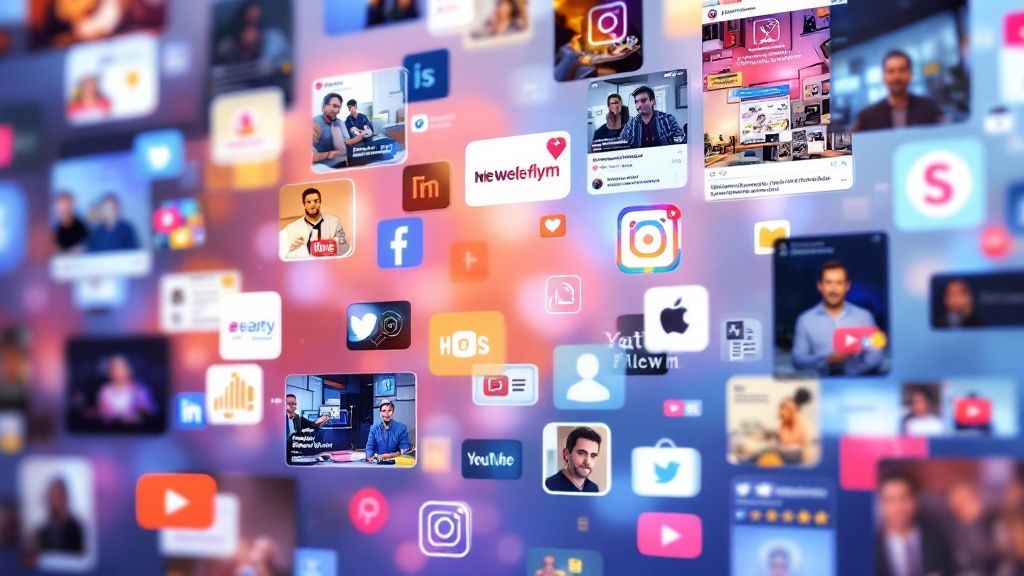
8 Personal Branding Presentations Strategies That Will Make You Shine
Level Up Your Personal Brand
Your personal brand is a defining aspect of your professional identity. As a leader in tech or business, how you present yourself shapes perceptions, opens doors, and creates opportunities. Consider how Apple's Steve Jobs mastered this – his presentations weren't just about products, but about crafting a compelling personal narrative that resonated with audiences worldwide.
Strong personal branding comes down to two key elements: authenticity and impact. The most memorable presentations go beyond sharing information – they tell a story, make meaningful connections, and leave audiences with clear takeaways. When you can align your unique expertise and perspective with what your audience needs, that's when personal branding magic happens.
- For impactful personal branding presentations:
- Focus on your authentic voice and story
- Craft clear, memorable messages
- Build genuine connections with your audience
- Share insights that provide real value
- Develop a consistent, recognizable style
This section will show you how to transform standard presentations into powerful personal branding tools. You'll learn practical strategies to showcase your expertise while creating lasting impressions that strengthen your professional reputation and influence.
1. Storytelling-Based Personal Brand

A strong personal brand helps leaders stand out and make real connections with their audience. For CTOs, CEOs, founders and entrepreneurs, storytelling offers a powerful way to share who you are and what you believe in. Rather than just listing accomplishments, weaving your experiences into a compelling narrative helps build trust and create lasting impact.
The key is crafting your story with a clear beginning, middle and end. Share the meaningful moments and challenges that shaped you. Focus on experiences that showcase your values and expertise. When you open up and tell authentic stories, you create an emotional bond with your audience that facts and figures alone cannot match.
Key Elements of Story-Based Personal Branding:
- Strong narrative structure: Frame your journey with meaningful turning points and growth
- Real experiences and examples: Use specific stories to illustrate who you are
- Authentic emotional connection: Help your audience relate to your experiences
- Consistent messaging: Tell your story consistently across all platforms
Benefits:
- Creates lasting impact: Stories resonate more deeply than data
- Builds genuine connections: Sharing experiences helps people relate to you
- Establishes credibility: Authenticity creates trust
- Makes you memorable: Your unique story helps you stand out
Challenges:
- Requires openness: Sharing personal stories means being vulnerable
- Takes time to develop: Crafting your narrative requires effort
- Must stay authentic: Your story needs to reflect who you really are
Real-World Examples:
- Brené Brown: Her personal stories about vulnerability and courage have inspired millions
- Gary Vaynerchuk: Shares his immigrant background and entrepreneurial path openly
- Sara Blakely: Built Spanx's brand around her authentic founding story
Tips for Success:
- Choose meaningful moments: Focus on experiences that shaped your path
- Share key insights: Explain what you learned from challenges
- Practice natural delivery: Make your storytelling conversational
- Connect with your audience: Adapt stories to resonate with different groups
Leading communicators like Simon Sinek, Donald Miller, and Nancy Duarte have shown how powerful storytelling can be. By sharing your authentic journey, you can create a personal brand that truly connects with people and leaves a lasting impression.
2. Visual Identity System
A strong personal brand needs more than just good messaging. A well-crafted Visual Identity System helps you break through the noise and create a lasting impression. This essential brand element ensures your visuals remain consistent and professional everywhere your brand appears, making you instantly recognizable to your target audience. For business leaders and entrepreneurs, having clear visual guidelines is a key part of effective personal branding.

A Visual Identity System does much more than provide a logo. It creates a complete visual language that reflects your brand's core message through these key elements:
- Color Palette: Choose colors that connect with your audience emotionally. For example, Marie Forleo's B-School uses vibrant yellow to convey energy and optimism.
- Typography: Your font choices shape how people perceive your brand. Modern sans-serif fonts suggest forward-thinking, while serif fonts often signal expertise and reliability.
- Logo Design: Your logo serves as the visual anchor for your brand. Consider how Tony Robbins' simple yet memorable logo became instantly recognizable.
- Design Templates: Create consistent templates for presentations, social media, and marketing materials to save time and maintain brand consistency.
- Image Guidelines: Set clear rules for photos and graphics. Lewis Howes uses warm, friendly imagery that matches his approachable personal brand.
Key Benefits of a Visual Identity System:
With most communication happening through screens, strong visuals matter more than ever. A consistent visual system helps you:
- Get Recognized: People quickly spot and remember your content when your visuals stay consistent
- Look Professional: Clean, polished visuals build trust with potential clients and partners
- Stay Consistent: Your brand looks unified across your website, social profiles, and marketing
- Make an Impact: Strong visuals create lasting impressions in people's minds
Pros and Cons:
Pros: Quick recognition, professional appearance, consistency across platforms, memorable impact
Cons: Professional design services can be expensive, and visual elements need regular updates to stay current
How to Implement Your Visual System:
- Start With Values: Let your core message guide your visual choices
- Document Everything: Create detailed guidelines for colors, fonts, logos, and images
- Stay Consistent: Follow your guidelines for every piece of content
- Test Thoroughly: Make sure your visuals work well on all devices and platforms
When you invest in a solid Visual Identity System, you're building a powerful tool that strengthens your personal brand and helps you connect more effectively with your audience.
3. Thought Leadership Platform
A well-planned Thought Leadership Platform helps you become a recognized expert in your field. It goes beyond simple personal branding to create real influence and open new opportunities. For business leaders, having strong thought leadership isn't optional – it's essential for standing out and driving growth.
Why it Matters: Your expertise and unique perspectives are valuable assets. When you share insights consistently, you build trust with your audience and position yourself as a go-to expert. This opens doors to new business opportunities and partnerships.
Key Features of a Thought Leadership Platform:
- Original Research & Analysis: Share unique data and expert perspectives that only you can provide
- Regular Content Creation: Post blogs, articles, videos or podcasts on a consistent schedule
- Public Speaking: Present at industry events, webinars and podcasts
- Expert Commentary: Engage thoughtfully in industry discussions and share informed views
Benefits:
- Expert Status: Regular sharing of valuable insights establishes you as a trusted authority
- Income Opportunities: Speaking engagements, consulting, courses and premium content
- Network Growth: Attracts potential investors, partners and top talent
- Lasting Impact: Compounds over time as your reputation and influence grow
Challenges:
- Time Investment: Requires consistent effort to create quality content
- Content Creation: Need to regularly produce fresh, valuable material
- Building Authority: Takes patience and persistence to establish credibility
Success Stories:
- Seth Godin: Built authority through daily blogging and books about marketing, developing a dedicated following
- Malcolm Gladwell: Made complex psychology accessible through engaging books and articles
- Neil Patel: Established marketing expertise through comprehensive blog content and tools
Key Implementation Steps:
- Find Your Focus: Pick a specific area of expertise where you can add unique value
- Create Quality Content: Share practical insights that solve real problems
- Build Relationships: Connect with other experts to expand your reach
- Share Fresh Takes: Offer new perspectives that help you stand out
By thoughtfully building your platform over time, you can grow your professional reputation, attract exciting opportunities, and make a meaningful impact in your industry. While it requires dedication, the long-term benefits make it worthwhile.
4. Digital-First Personal Brand

Building a strong online presence is now essential for any business leader. Your digital brand directly impacts your professional success, whether you're a CTO, CEO, founder or entrepreneur. The online world gives you direct access to your audience without traditional gatekeepers, making it possible to shape your public image and establish yourself as an expert.
When done well, a digital-first approach helps you reach more people, measure your impact, and grow your influence cost-effectively compared to offline methods. Social media and content platforms have created new opportunities for individuals to build their reputation and connect with their target audience.
A well-crafted digital brand includes these core elements:
- Active social platforms: Regular engagement and valuable content sharing on key networks
- Professional website: Your digital home base featuring your expertise through articles and media
- Content strategy: A structured plan for creating helpful content that resonates with your audience
- Online relationship building: Making meaningful connections through LinkedIn and industry communities
Real-world success stories:
- Gary Vaynerchuk: Built his influence through authentic social media content and entrepreneurship insights
- Pat Flynn: Created the Smart Passive Income brand by openly sharing his online business experiences
- Marie Forleo: Developed a powerful platform focused on helping entrepreneurs and creatives succeed
Key advantages of going digital-first:
- Wide reach: Connect with people globally without geographic limits
- Clear metrics: Track progress with data and refine your approach
- Budget-friendly: Build presence without major upfront costs
- Always on: Your content works for you 24/7
Important challenges:
- Platform risk: Changes to social networks can affect your visibility
- Ongoing effort: Maintaining presence requires consistent work
- Audience fatigue: Information overload can reduce engagement
- Tech changes: Keeping up with platform updates needs attention
Practical steps to build your digital brand:
- Pick key platforms: Focus on where your target audience spends time
- Plan content ahead: Create an editorial calendar for consistency
- Stay engaged: Reply to comments, join discussions, build connections
- Study your data: Use analytics to improve your content and approach
A digital-first strategy helps you showcase expertise, grow your network, and strengthen your professional reputation. This focused effort supports key goals like fundraising, hiring, and business growth through a strong online presence.
5. Personal Value Proposition
A strong personal brand is essential for executives, entrepreneurs, and startup founders. At its core is your Personal Value Proposition (PVP) – a clear statement that shows your unique value and sets you apart from others in your field. This positioning helps define how your target audience perceives and remembers you.
Your PVP directly answers: "Why should someone choose you?" It shapes every aspect of your professional presence – from networking to your online profiles to how you present yourself in business settings.
Key Features of a Strong PVP:
- Unique Selling Proposition (USP): What special combination of skills and experience do you offer?
- Target Audience Focus: Your message must connect with your ideal audience (investors, clients, employers)
- Problem-Solution Framework: Show how you solve specific challenges for your audience
- Clear Positioning: Define your expertise and the concrete value you deliver
Benefits of Having a PVP:
- Stand Out: Clearly establish your area of expertise
- Consistent Message: Communicate the same value across all channels
- Better Choices: Know which opportunities align with your brand
- Differentiation: Set yourself apart in your field
Potential Drawbacks:
- May Miss Opportunities: A narrow focus could limit some options
- Needs Updates: Skills and markets change, requiring PVP adjustments
- Not Universal: A specific message won't resonate with everyone
Tips for Creating Your PVP:
- Study Competitors: Know what others offer and find your unique angle
- List Your Strengths: What do you do exceptionally well?
- Get Feedback: Test your PVP with your target audience
- Keep Refining: Update as you grow and markets change
Background & Development:
The value proposition concept has deep roots in business strategy. Management expert Peter Drucker stressed understanding customer needs, while Tom Peters brought these ideas to personal branding through his "brand you" work. Today, a clear PVP is crucial for professional success.
Real Example:
Compare two AI engineers: One says "Experienced AI developer." Another says "I help e-commerce companies use AI to personalize shopping experiences and boost sales by 20%." The second PVP clearly shows the audience, problem solved, and measurable results.
Why PVP Matters:
For leaders and entrepreneurs, your personal brand drives success in attracting talent, funding, and partnerships. Your PVP is the foundation – it helps you focus your efforts and stand out. Time spent crafting a strong PVP is an investment in achieving your professional goals.
6. Signature Speech/Presentation

A signature presentation can help business leaders stand out and build credibility. For executives and entrepreneurs, crafting a distinctive talk that reflects your expertise and resonates with audiences is a powerful way to strengthen your personal brand.
Consider how Steve Jobs' product launches became legendary events that defined Apple's identity. Or how Sir Ken Robinson's TED Talk on education went viral and established him as a leading voice in his field. These weren't random talks – they were carefully designed with clear messages and compelling storytelling.
A great signature speech creates an experience and leaves a lasting impression. Here are the key elements:
- Core Message: Focus on one central idea that aligns with your expertise and values
- Distinctive Style: Develop your unique approach through storytelling, humor or visuals
- Active Engagement: Include audience interaction through questions and discussion
- Rich Media: Use images, video and audio to reinforce key points
The rise of TED Talks and online video has made signature presentations more important than ever. A well-crafted talk can reach global audiences and boost your visibility exponentially.
Benefits:
- Greater Visibility: An engaging presentation attracts media coverage and speaking invites
- Expert Status: Consistently delivering valuable insights positions you as a thought leader
- New Opportunities: A strong talk leads to conference invitations and business leads
- Additional Revenue: Your signature speech can open doors to paid speaking gigs
Challenges:
- Less Flexibility: One core message may limit adaptability for different audiences
- Time Investment: Refining and practicing your talk requires significant effort
- Regular Updates: Content needs refreshing to stay current and compelling
Tips for Creating Your Signature Talk:
- Pick One Key Message: What's the most important takeaway for your audience?
- Share Real Stories: Personal examples create emotional connections
- Practice Extensively: Rehearse until delivery feels natural
- Keep it Fresh: Update with new examples and insights regularly
A signature presentation helps establish your expertise and connect with audiences authentically. With thoughtful preparation and consistent delivery, your talk can become a cornerstone of your personal brand and open new professional opportunities.
7. Personal Brand Ecosystem
Building a personal brand goes far beyond having a LinkedIn profile or posting a few tweets. The key is creating a personal brand ecosystem – a network of connected touchpoints across multiple platforms that work together to share your message and build influence. This approach helps establish a lasting presence that resonates with your target audience.
Your brand is like a living system. A single social media profile is just one small piece, but a full ecosystem is robust and resilient, like a thriving forest. When all your platforms work together in harmony, that's when your personal brand truly comes alive.
Key Elements of a Personal Brand Ecosystem:
- Strategic platform selection: Choose platforms where your target audience spends time. For developers, focus on GitHub and Stack Overflow. For investors, prioritize LinkedIn and speaking events.
- Unified core message: While content varies by platform, maintain consistency in your key value proposition and brand identity across channels.
- Smart cross-promotion: Drive engagement by promoting content across platforms. Share your newsletter on your podcast, link blog posts on social media, and mention your latest articles across channels.
- Content adaptation: Get more value from your content by adapting it for different platforms. Transform blog posts into social threads, visual graphics, or podcast segments.
Benefits:
- Broader reach: Connect with more people through multiple platforms
- Income diversification: Open up new revenue streams through courses, affiliate marketing, speaking, and consulting
- Industry authority: Build recognition as a thought leader through consistent, valuable content
- Stability: Protect against platform changes by maintaining presence across channels
Challenges:
- Management complexity: Coordinating multiple platforms requires careful planning
- Resource demands: Building an ecosystem takes significant time and effort
- Team needs: Growth often requires help with content creation and community engagement
Success Stories:
- Tim Ferriss: Built an empire spanning bestselling books, a top podcast, blog content, and courses reaching millions
- Marie Forleo: Created a powerful ecosystem combining her B-School program with social media, email marketing and YouTube content
- Gary Vaynerchuk: Developed a media company through relentless content creation across social platforms, podcasts and speaking
Key Implementation Steps:
- Start focused: Begin with 2-3 core platforms where your audience is most active
- Plan your content: Create a content strategy that aligns with your brand message and each platform's style
- Grow steadily: Add new platforms gradually as you build experience and resources
- Stay consistent: Publish quality content regularly and engage with your audience across channels
A personal brand ecosystem is a smart investment in your future success. By building connected touchpoints across platforms, you can reach more people and create a lasting brand. This approach helps leaders stand out and connect with their audience in meaningful ways.
8. Personal Brand Authenticity
A genuine personal brand stands out in an oversaturated world of self-promotion. It's a key foundation for building real influence and meaningful connections. For high-level executives, startup founders, and business leaders, being authentic isn't optional – it's essential for earning trust and motivating teams.
True authenticity means being yourself both online and offline. Your communication should reflect your core values and beliefs. Share your perspectives and experiences openly and honestly. Most importantly, follow through on your words with aligned actions. Keep growing and developing yourself to strengthen your authentic brand over time.
Real-World Examples:
- Michelle Obama: Her relatable, down-to-earth personality shines through her advocacy work and speaking engagements. She connects with audiences by sharing personal stories and experiences.
- Richard Branson: His adventurous spirit and bold personality define his brand. By openly sharing both successes and failures, he remains relatable and human.
- Oprah Winfrey: She built her empire on genuine connection. Her empathy and willingness to be vulnerable about her own challenges created deep trust with viewers.
The Rise of Authenticity:
Leading voices like Brené Brown and Simon Sinek have highlighted why authenticity matters. Brown's research shows the power of embracing imperfection. Sinek's work on "starting with why" helps leaders connect with audiences through clear purpose and values.
Why Authenticity Matters in Personal Branding:
An authentic brand deserves attention because it drives lasting success. When you're genuine, you build real trust and loyal supporters. Your unique experiences and values naturally set you apart. Plus, being yourself takes less effort than maintaining a fake persona.
Pros:
- Long-term stability
- Deep audience trust
- Natural differentiation
- Less maintenance needed
Cons:
- May limit certain opportunities if values clash
- Requires being vulnerable
- Takes time to build genuine trust
Tips for Building an Authentic Brand:
- Define your core values: Know the principles that guide your decisions
- Share real stories: Connect through personal experiences that show your values
- Stay true to principles: Don't compromise values for quick wins
- Be consistent: Match your online and offline presence
By being authentic, you create a personal brand that truly resonates and builds lasting connections. This approach helps both your career growth and personal fulfillment.
Personal Branding Strategy Comparison: 8 Key Approaches Evaluated
| Method | Difficulty | Time Required | Results | Best For | Key Benefit |
|---|---|---|---|---|---|
| Storytelling-Based Personal Brand | Moderate 🔄 | High ⚡ (Time intensive) | High 📊 (Memorable impact) | Authentic storytellers and thought leaders | Emotional connection ⭐ |
| Visual Identity System | Moderately High 🔄 | Medium ⚡ | Professional 📊 (Instant recognition) | Designers & brand-focused professionals | Consistent visual impact ⭐ |
| Thought Leadership Platform | High 🔄 | High ⚡ (Long buildup) | Credibility 📊 (Authority) | Niche experts & industry influencers | Authority and diversified revenue ⭐ |
| Digital-First Personal Brand | Low-Moderate 🔄 | Medium ⚡ | Global 📊 (High visibility) | Digital influencers & content creators | Broad, measurable online impact ⭐ |
| Personal Value Proposition | Moderate 🔄 | Low-Moderate ⚡ | Focused 📊 (Clear positioning) | Professionals seeking distinct messaging | Clear market differentiation ⭐ |
| Signature Speech/Presentation | Moderate 🔄 | Medium-High ⚡ | High 📊 (Engaging delivery) | Public speakers and industry figures | Memorable, high-impact communication ⭐ |
| Personal Brand Ecosystem | High 🔄 | High ⚡ | Comprehensive 📊 (Integrated reach) | Brands with multi-channel presence | Resilient, interconnected brand experience ⭐ |
| Personal Brand Authenticity | Low-Moderate 🔄 | Low ⚡ | Trust-building 📊 (Sustainable) | Individuals valuing genuine engagement | Enduring, authentic connection ⭐ |
Craft Your Winning Presentation
A compelling personal brand presentation requires three key ingredients: deep self-awareness, clear audience understanding, and skillful communication. At its core are eight essential elements – your brand story, visual identity, thought leadership, digital presence, value proposition, signature talk, brand ecosystem, and authentic voice.
Start by getting crystal clear on your personal brand foundation. Ask yourself: What do you truly value? What unique expertise can you share? Who needs to hear your message most? Once you've mapped this out, you can build your messaging, design your visual elements, and establish your online platforms. The key is delivering real value to your audience while positioning yourself as a trusted voice in your field. Your signature presentation should bring all these pieces together naturally.
Your personal brand needs regular care and updates as audience needs shift. Pay attention to what's working in brand communication, like short video content and genuine community engagement. Take time to review your presentation materials and brand elements periodically. Listen to feedback and adapt your approach based on what resonates with your audience. This helps keep your brand fresh and impactful.
Key Takeaways:
- Stay True to You: An authentic voice builds trust and connection
- Share Your Story: Use compelling narratives to showcase your journey and expertise
- Create Visual Impact: Strong design reinforces your brand message
- Build Online Presence: Connect with your audience across key digital channels
- Keep Evolving: Review and refresh your brand regularly
Bhavik Sarkhedi & Co. helps founders, CEOs and entrepreneurs develop powerful personal brands that drive real business results. We focus on strategic storytelling and targeted content that positions you as a respected industry voice. Our approach combines compelling narratives with smart digital strategy to help you stand out authentically. Visit Bhavik Sarkhedi & Co. to learn how we can help elevate your personal brand and achieve your business goals.

